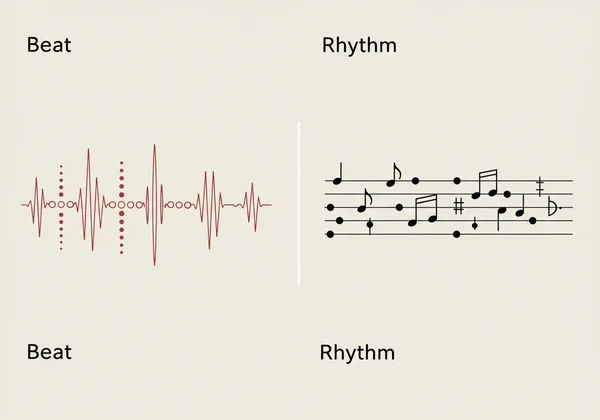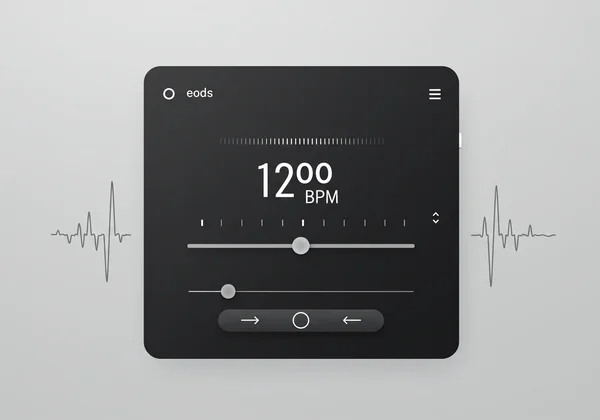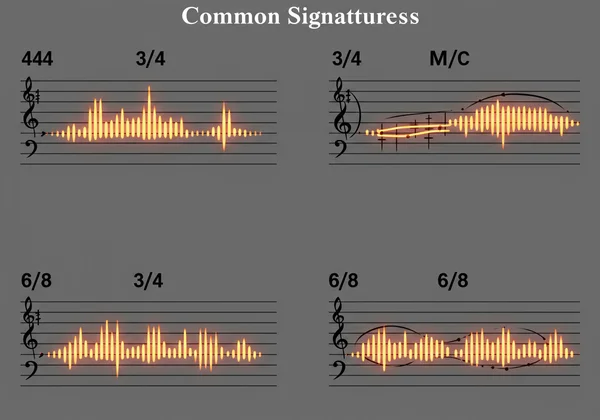在线节拍器指南:掌握节拍、速度和拍号
即使是经验丰富的音乐家,还在为找不到节奏而苦恼吗?事实上,扎实的 节奏基础——节拍、速度和拍号——是音乐精准度的基石。本指南将阐明这些概念,并展示精确的 在线节拍器 如何改变您的练习。请在下方探索这些基本概念,并立即试用我们的 免费节拍器 工具。
理解脉搏:什么是节拍?
音乐的核心就像一个心跳——那个我们称之为节拍的稳定、重复的 脉搏。将其视为音乐中时间的基本规律单位。当您随着歌曲打拍子时,您很可能是在感受节拍。它赋予音乐前进的动力,并在演奏或跳舞时帮助我们保持同步。掌握这个 理解节拍 的概念是实现真正节奏自由的第一步。
节拍与节奏:剖析关键区别
虽然经常可以互换使用,但节拍和节奏是截然不同的概念。节拍是稳定不变的 脉搏,就像时钟的滴答声。而 节奏 则指的是建立在稳定节拍之上的声音和休止符随时间排列的方式。 节奏 使旋律变得有趣且富有变化。它是长短音符、休止符和重音的模式,赋予乐曲以性格,而节拍则提供了恒定的框架。将节拍想象成画布, 节奏 则是画布上创作的画作。掌握您的 节奏基础 至关重要。

寻找内在节拍器:如何持续感受节拍
培养持续的内在节拍对任何音乐家都至关重要。这意味着能够无需外部帮助地感受和维持 节拍。从聆听 在线节拍器 发出的稳定滴答声开始。只专注于 节拍,并尝试精确地打拍子。然后,尝试内化这种感觉,移开节拍器并继续打拍子。这个练习有助于您培养固有的 精准计时 感。与高质量 在线节拍器 提供的视觉辅助工具进行持续练习,可以极大地提高这项技能。
音乐的速度:什么是速度(BPM)?
理解了节拍之后,下一步就是理解这些节拍移动的速度。这就是 什么是速度 的含义所在。速度是指音乐中节拍的快慢。它决定了乐曲的整体步调,影响其情绪和能量。无论是缓慢的抒情歌还是快节奏的摇滚歌曲,速度都赋予音乐其特有的步调。
音乐中的BPM代表什么?(每分钟节拍定义)
那么, 音乐中的BPM代表什么? BPM 代表 Beats Per Minute(每分钟节拍数)。它是速度的标准测量单位,精确指示每分钟发生的节拍数。较高的 BPM 意味着较快的速度,而较低的 BPM 则表示较慢的速度。例如,“节拍器 120 bpm”意味着一分钟有 120 个节拍,这是一个相当适中的速度。这种清晰客观的测量方式使世界各地的音乐家能够准确地交流和复制音乐速度。为了精确控制,请使用 在线节拍器 作为您的 BPM 工具。

設定您的練習速度:選擇正確的BPM
什么是好的练习BPM? 没有唯一的答案,因为理想的 BPM 取决于乐曲、您的技能水平以及您的具体练习目标。一般来说,始终从慢速开始。如果一首乐曲感觉太快,请显著降低速度,专注于准确性和流畅性,然后再逐渐增加 BPM。这种 练习节奏 策略可以防止沮丧,并建立牢固的肌肉记忆。我们的互动式 BPM 工具 可帮助您找到完美的速度,通过简单的控件进行调整,甚至可以使用独特的 手动测速 功能快速找到您所需的速度。
组织声音:拍号解释
除了单个节拍及其速度之外,音乐还被组织成重复的节拍组,形成 音乐小节。这种组织由 拍号解释 来定义。拍号告诉您两件关键事情:每个小节有多少个节拍,以及哪种音符获得一个节拍。它是赋予音乐结构并帮助我们数拍子的节奏蓝图。
解码常见的拍号(4/4、3/4、6/8)
让我们来分解一些 常见拍号:
- 4/4 拍(Common Time):这可以说是西方音乐中最普遍的拍号。顶部的“4”表示每个小节有四个节拍。底部的“4”表示四分音符获得一个节拍。您会在大多数流行、摇滚和古典音乐中找到 4/4 拍。
- 3/4 拍(华尔兹拍):这里,每个小节有三个节拍,四分音符仍然获得一个节拍。这种拍号赋予音乐特有的“一二三”感觉,通常与华尔兹相关。
- 6/8 拍:这个有点不同。顶部的“6”表示每个小节有六个节拍,但底部的“8”表示八分音符获得一个节拍。这会产生一种复合拍,通常感觉像是两个主要节拍,每个节拍又分为三个八分音符,赋予一种流畅、轻快的特质。
理解这些模式对于驾驭 音乐结构 至关重要。我们的 在线节拍器 允许您自定义拍号,以匹配您正在练习的任何乐曲。
可视化节拍:为什么拍号很重要
为什么拍号很重要,这不仅在于数拍子。它们提供了 节奏框架,决定了乐句如何成形以及音乐如何呼吸。它们影响重音落在何处(例如,小节的第一个强拍),以及乐曲在节奏上感觉如何。没有对拍号的清晰理解,音乐听起来可能会很混乱。使用 在线节拍器 的视觉化功能可以加深您的理解,准确显示每个节拍和重音在小节内的位置。这种可视化对于处理 复杂节奏 和确保您的 音乐表达 精准特别有帮助。

您的信心节奏之旅即刻启程
掌握 节奏基础——理解节拍、精确设置您的 速度(BPM) 以及准确解读 拍号——是实现真正音乐精通的必要条件。这些不仅仅是理论;它们是能够赋予您以坚定信心和精准度进行演奏、创作和表演的实用工具。
准备好将这些概念付诸实践了吗?我们的 在线节拍器 提供了一个免费、高度可定制且易于使用的平台,专为所有音乐家、学生和教师设计。凭借诸如 手动测速、可调的 节拍器拍号 设置以及各种声音选项等功能,它是完美的 节奏训练 伴侣。
不要让节奏挑战阻碍您前进。立即访问 Metronome.wiki 开始您通往完美节奏的旅程。精准练习,充满激情地演奏,真正提升您的音乐造诣!
关于节奏基础的常见问题解答
音乐中的BPM代表什么?
BPM 代表 Beats Per Minute(每分钟节拍数)。它是速度的标准度量单位,表示每分钟的节拍数,定义了音乐的速度或快慢。您可以在任何优质的 在线节拍器 工具上轻松设置您所需的速度 BPM。
节拍器能提高我的节奏吗?
绝对可以!节拍器是提高您 节奏 的宝贵工具。通过提供稳定、不变的 节拍,它可以帮助您内化 精准计时,识别您演奏中的不一致之处,并建立强大的 节奏基础。持续使用可显著 提高节奏。
如何找到一首歌的速度?
您可以使用 在线节拍器 工具上的 手动测速 功能来 找到歌曲的速度。只需跟着歌曲的节拍点击,工具就会为您计算出 BPM。这是快速准确地 找到速度 的最实用方法之一。在 Metronome.wiki 上尝试一下,轻松确定歌曲的速度。
节拍和节奏有什么区别?
节拍 是音乐中稳定不变的、潜在的 脉搏——就像心跳一样。 节奏 指的是在那个稳定的节拍之上演奏的音符和休止符的特定模式。将节拍视为稳定的框架,将 节奏 视为该框架内声音和休止符的排列方式,从而赋予音乐独特的特质。